Caryn’s Thoughts
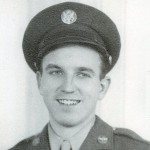
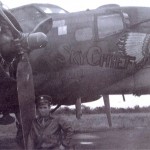 After World War II, many of the veterans were hesitant to talk about their experiences. My dad, Allen Spencer was one of those men. We were never exactly sure why he didn’t talk about it, but thought that he didn’t want to brag. I don’t really think that was it at all.
After World War II, many of the veterans were hesitant to talk about their experiences. My dad, Allen Spencer was one of those men. We were never exactly sure why he didn’t talk about it, but thought that he didn’t want to brag. I don’t really think that was it at all.
While listening to an audiobook called Citizen Soldiers, which covers the D-Day battle and the Battle of the Bulge, it hit me…even before the author said it. The reason soldiers didn’t talk much about war was a deliberate effort to forget. Unfortunately for most of her them, forgetting was impossible. Their minds were filled with haunted memories. The book mostly covers the thoughts of the infantry, but touches on the air war too.
After listening to the author’s account of the battle, I don’t think I could ever forget either, and I wasn’t there. Memories of the 19 year old farm boy away from home for the first time, and not really trained for combat. When the shooting started, he stood up to fire. Other soldiers told him to get down, by it was too late. His first battle had become his last, as an enemy bullet pierced his forehead. The soldiers who witnessed it, felt sick to 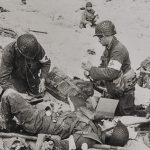
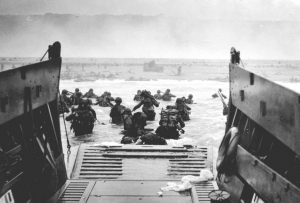 their stomachs. It was a time when a seasoned veteran was just 22 years old…and he had been made an office when his commanding officer was killed. There weren’t very many of the older men left…and by older I mean 30.
their stomachs. It was a time when a seasoned veteran was just 22 years old…and he had been made an office when his commanding officer was killed. There weren’t very many of the older men left…and by older I mean 30.
There were memories of a young prisoner of war, packed into a train to the POW camps was singing in his beautiful tenor voice, all the Christmas music he could think of to help raise moral. It was working, but suddenly the trains were under attack. The prisoners couldn’t get out, and the guards had run away. Finally a skinny boy was able to get out through a tiny window. He opened the door to his car and the men moved to free the other prisoners. There was really nowhere to go, but they escaped the attack. Then, the guards came back and loaded them back on the train. When someone asked the tenor to sing some more, they were told that he hadn’t made it back. His sweet voice was forever silenced. The men on the train were silent too…sick at heart.
The fighters in the plane’s overhead knew that it was kill or be killed, but whenever a plane went down, enemy 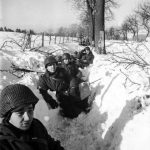
 or one of theirs, they counted the parachutes, hoping the men got out alive. For them non the planes dropping bombs, they knew that someone below went to work that day, having no idea tat they would not be returning home again. They had been simple factory workers, just doing what they were told. And what of the missed targets that landed bombs on schools and other civilian locations. The men in the planes above had to live with that. They had done their duty, but it certainly didn’t feel good.
or one of theirs, they counted the parachutes, hoping the men got out alive. For them non the planes dropping bombs, they knew that someone below went to work that day, having no idea tat they would not be returning home again. They had been simple factory workers, just doing what they were told. And what of the missed targets that landed bombs on schools and other civilian locations. The men in the planes above had to live with that. They had done their duty, but it certainly didn’t feel good.

 As another of my father-in-law, Walt Schulenberg’s birthday has arrived, I find myself unable to believe that he has been in Heaven for over six years now. Today, he would have been 90 years old. Somehow, I can’t imagine that he could have been that old…mostly, I suppose, because he never really acted like an old man. He always seemed young and full of life. He was busy and always working on some project. I know he slowed down some in the last year or so of his life, but it still didn’t strike me that he was growing older. Maybe because I saw him just about every day in those last few years. You somehow don’t see what is right in front of you when you are there every day. He always seemed the same vibrant workaholic that I had know all the years that he was my father-in-law.
As another of my father-in-law, Walt Schulenberg’s birthday has arrived, I find myself unable to believe that he has been in Heaven for over six years now. Today, he would have been 90 years old. Somehow, I can’t imagine that he could have been that old…mostly, I suppose, because he never really acted like an old man. He always seemed young and full of life. He was busy and always working on some project. I know he slowed down some in the last year or so of his life, but it still didn’t strike me that he was growing older. Maybe because I saw him just about every day in those last few years. You somehow don’t see what is right in front of you when you are there every day. He always seemed the same vibrant workaholic that I had know all the years that he was my father-in-law.
He was a happy man, who had a great sense of humor and loved life. He cherished every grandchild and great grandchild as they came along, and I know he would have loved his great great granddaughter too. I wish they could have met. They would have gotten along splendidly. He was always a family man, and there was nothing that was more important to him than his kids and grandkids. He loved to make things for them, and was thrilled as they played with each new toy. His craftwork was in many ways, ahead of its time. He loved to tinker in the garage, and his craft barn, where he created his unique designs, and got them read to give to someone, or to sell at one of the craft fairs.
His crafts were great, but he was a great builder too. He built the family home in the country, in the late 70s, and dressed up the house they had in town, after they moved. He refurbished lawn chairs with a fresh new classic design, that made them more a showpiece than a lawn chair. And he also built puzzles for people to try their luck at. Some of them were quite difficult to solve. I think it was all a part of the kid in him and maybe 
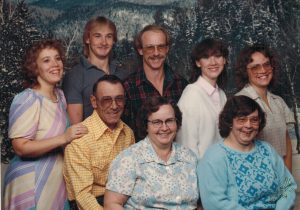 that’s why he never seemed to age. I think you have to grow up to age…don’t you? I will never forget the years that I was blessed to have Walt Schulenberg as my father-in-law. He made life fun, and he always made a person feel loved. I always knew where I stood with him…and it was a great place to be. A place of honor and respect, and yes, a place of fun and laughter too. Today would have been my father-in-law’s 90th birthday. Happy birthday in Heaven, Dad!! We love and miss you very much.
that’s why he never seemed to age. I think you have to grow up to age…don’t you? I will never forget the years that I was blessed to have Walt Schulenberg as my father-in-law. He made life fun, and he always made a person feel loved. I always knew where I stood with him…and it was a great place to be. A place of honor and respect, and yes, a place of fun and laughter too. Today would have been my father-in-law’s 90th birthday. Happy birthday in Heaven, Dad!! We love and miss you very much.

 My niece, Lindsay Moore is married to Shannon Moore, who is the University of Wyoming’s assistant coach. He is also the tight ends coach, and helps with special teams. Basically, that makes Lindsay, the coach’s wife…something she has been all of their married life. Being the wife of a college football coach means that you are very likely to move around a bit. As better positions come up, coaches move into them. Shannon started out as the coach of the Wyoming Cavs, then went to South Dakota State University, then Miami International University, then to East Carolina University, and not to the University of Wyoming, which is also one of Lindsay’s Alma Maters. The last move was special for both of them, because it brought them closer to home and their families.
My niece, Lindsay Moore is married to Shannon Moore, who is the University of Wyoming’s assistant coach. He is also the tight ends coach, and helps with special teams. Basically, that makes Lindsay, the coach’s wife…something she has been all of their married life. Being the wife of a college football coach means that you are very likely to move around a bit. As better positions come up, coaches move into them. Shannon started out as the coach of the Wyoming Cavs, then went to South Dakota State University, then Miami International University, then to East Carolina University, and not to the University of Wyoming, which is also one of Lindsay’s Alma Maters. The last move was special for both of them, because it brought them closer to home and their families.
Still, Lindsay’s job didn’t change…at least not her job as the coach’s wife. When a man is a football coach, he becomes a father figure to his team, in many ways. That puts Lindsay then, as a mother figure, and it doesn’t matter how close in age the coach and his wife are to the ages of their players. Lots of these guys are far away from home, many for the first time in their lives, and it’s nice to have someone who makes them feel welcome and nurtured, like their parents once did. They are grown up men, but a little bit of parenting kindness never hurt anything. And the players always enjoy the social events thrown for them.
Lindsay has always been a very social person, so throwing team parties if something she take is stride, and since she never met anyone she didn’t like, he is a friend to all. Then there is Lindsay and Shannon’s daughter, Mackenzie, who is like the littlest team cheerleader…and of course, it is the job of the coach’s wife to make sure everyone…even the littlest cheerleader has their game face on. And in that respect, Lindsay has taught her 
 little Mackenzie well. Being a coach’s wife is not an easy job, and I’m sure it is one I couldn’t do, because I am nowhere near as social as Lindsay is, but for her, other than her jobs as consultant, exercise instructor, and most importantly, mom…Lindsay is the best coach’s wife I can imagine. It’s right up her alley. And it’s gonna be a great year!! Today is Lindsay’s birthday. Happy birthday Lindsay!! Have a great day!! We love you!!
little Mackenzie well. Being a coach’s wife is not an easy job, and I’m sure it is one I couldn’t do, because I am nowhere near as social as Lindsay is, but for her, other than her jobs as consultant, exercise instructor, and most importantly, mom…Lindsay is the best coach’s wife I can imagine. It’s right up her alley. And it’s gonna be a great year!! Today is Lindsay’s birthday. Happy birthday Lindsay!! Have a great day!! We love you!!
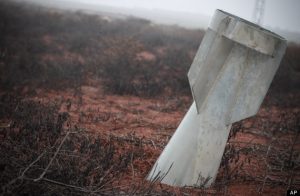 I have long been interested in war, and especially World War II. Every aspect of it interests me, and I find myself wondering about the enemy. I’m sure that might seem odd to many people, but as we have found in the United States, just because the government goes to war, does not mean that every citizen, or even every soldier agrees with the reasons the country has gone to war. I have been listening to a couple of audiobooks that have taken in D-Day, and I came across something interesting.
I have long been interested in war, and especially World War II. Every aspect of it interests me, and I find myself wondering about the enemy. I’m sure that might seem odd to many people, but as we have found in the United States, just because the government goes to war, does not mean that every citizen, or even every soldier agrees with the reasons the country has gone to war. I have been listening to a couple of audiobooks that have taken in D-Day, and I came across something interesting.
Without going into all of that amazing strategy of warfare, I want to focus on one of the bombing maneuvers that took place. One of the soldiers on the ground was trying to take cover from incoming German bombs. After the bombing stopped, he looked out and was shocked to see eight bombs embedded in the ground near his foxhole. They had not gone off. He knew that it is possible for bombs to be duds, but he hadn’t heard of any American bombs that had turned out to be duds…especially eight of them at the same time, in the same place. 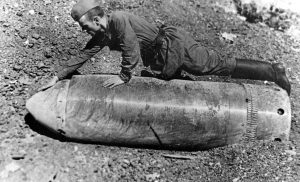 He wasn’t bragging on the American bombs, their craftmanship, or their ingenuity, but rather, wondering how so many German bombs could have been duds…all at the same time.
He wasn’t bragging on the American bombs, their craftmanship, or their ingenuity, but rather, wondering how so many German bombs could have been duds…all at the same time.
Then the soldier made an observation that I had not considered, but that fell right into my view that not everyone in Germany agreed with Hitler. The American bomb builders were doing their job willingly. They were working to make the bombs efficient, because Germany needed to be defeated. In contrast, the German bomb builders were actually Polish slaves. Hitler had invaded their nation and was forcing them to play a part in a war that they disagreed with. The soldier considered these things and came to the conclusion that somehow the Polish slaves had been able to build a bomb that they knew would not explode, but would still pass the inspections of the Germans. The soldier believed that eight unexploded bombs could not be coincidental. It had to be sabotage.
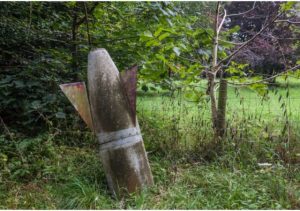
In my research, I have seen situations where the citizens have helped the enemy, at great risk to their own safety. I have seen situations where the citizens have given aid to the enemy. And this situation was a blatant sabotage of the weapons of warfare. Within their nations, these acts were acts of treason, but they were actually fighting the evil that had tried to take over their nation. Within their confines, they were standing up for their values…for good, and for what was right. They were the enemy, in location only, because in their hearts, the were fighting for what was right, and I have to respect them for that.

 It is so hard for me to believe that my grand-niece, Aurora Hadlock is 8 years old today. It seems like just yesterday that she arrived…such a sweet, pretty little baby girl. She was given the name of her mother, Chelsea Hadlock’s dreams…Aurora. The name Aurora means “Dawn” or “Sunrise,” and either one fits Aurora, because she has a sunshiny personality. She loves hanging out with friends, cousins, and her brother, Ethan. As siblings go, these two are very close. Ethan is protective of his sister, but doesn’t mind teasing her a bit either. Aurora can take it though, because they have grown up in a family of teasers, a long line of them really, dating back at least four generations.
It is so hard for me to believe that my grand-niece, Aurora Hadlock is 8 years old today. It seems like just yesterday that she arrived…such a sweet, pretty little baby girl. She was given the name of her mother, Chelsea Hadlock’s dreams…Aurora. The name Aurora means “Dawn” or “Sunrise,” and either one fits Aurora, because she has a sunshiny personality. She loves hanging out with friends, cousins, and her brother, Ethan. As siblings go, these two are very close. Ethan is protective of his sister, but doesn’t mind teasing her a bit either. Aurora can take it though, because they have grown up in a family of teasers, a long line of them really, dating back at least four generations.
Aurora is a smart little girl, who does well in school. She especially loves to read and make art. She also comes from a long line of musicians, dating back at least four generations, and she really loves to play the guitar with her dad and grandpa. I wish she could have played with her great grandpa, my dad, Allen Spencer, because he would have just loved having a little great granddaughter who could play the guitar. His own daughters weren’t really so inclined, with the exception of Aurora’s grandma, Allyn Hadlock, who played the violin, as did our dad.
Very soon, Aurora and her family are going to be moving into a bigger house. My sister and her husband, Chris, 
 Aurora’s grandparents are building a new home in the country, and Aurora’s parents are going to buy their current home. It is bigger, and will provide them with all the home they need for the rest of their lives. Aurora is very excited about the move, as is her brother, and it can’t come soon enough. The kids know that their grandparents house isn’t done yet, and they know that they will have to move when their old house is sold. So they have asked where their grandparents are going to live when they move into the house. Allyn laughed and said, “With you!!” The kids hadn’t thought of that, but they liked the idea. They love to spend the night over there, so now their grandparents can spend the night with them for a change. It’s an exciting time for Aurora. Today is Aurora’s birthday. Happy birthday Aurora!! Have a great day!! We love you!!
Aurora’s grandparents are building a new home in the country, and Aurora’s parents are going to buy their current home. It is bigger, and will provide them with all the home they need for the rest of their lives. Aurora is very excited about the move, as is her brother, and it can’t come soon enough. The kids know that their grandparents house isn’t done yet, and they know that they will have to move when their old house is sold. So they have asked where their grandparents are going to live when they move into the house. Allyn laughed and said, “With you!!” The kids hadn’t thought of that, but they liked the idea. They love to spend the night over there, so now their grandparents can spend the night with them for a change. It’s an exciting time for Aurora. Today is Aurora’s birthday. Happy birthday Aurora!! Have a great day!! We love you!!

 My nephew, Josh Griffith was raised in the country, and when he grew up, he knew that country life was how he wanted to raise his family too. When he and my niece, Susan were first married, they had a place in Powell, Wyoming, but it wasn’t in the country. Susan wasn’t raised in the country, but she wasn’t opposed to the idea of country life. She was nervous about things like 4-wheelers and horses, but Josh helped her get past her worries, and they began planning for a move to the country someday. It helped that Josh’s parents had horses, so that Josh could teach his girls, Jala and Kaytlyn, as well as Susan to ride them. Josh was a great teacher. Jala especially took to riding as if she had been born in the saddle. It took Susan a little longer, and Kaytlyn was a bit young at first, but as she grows, I know she will love riding too.
My nephew, Josh Griffith was raised in the country, and when he grew up, he knew that country life was how he wanted to raise his family too. When he and my niece, Susan were first married, they had a place in Powell, Wyoming, but it wasn’t in the country. Susan wasn’t raised in the country, but she wasn’t opposed to the idea of country life. She was nervous about things like 4-wheelers and horses, but Josh helped her get past her worries, and they began planning for a move to the country someday. It helped that Josh’s parents had horses, so that Josh could teach his girls, Jala and Kaytlyn, as well as Susan to ride them. Josh was a great teacher. Jala especially took to riding as if she had been born in the saddle. It took Susan a little longer, and Kaytlyn was a bit young at first, but as she grows, I know she will love riding too.
Susan had always loved camping, as her family liked to do, and I’m sure that Josh not only fit in, but probably convinced Susan that country life is quite similar to camping. As the time grew nearer, they grew more and more excited about buying their country house, and getting horses, and 4-wheelers. Then, in 2013, Josh and Susan moved their family to the country. They were so excited. Susan planned to grown a garden and can the food from it, and Josh couldn’t wait to get those horses. Of course, he also knew how life is in the country. There isn’t anyone to clear your street, because your street is usually a dirt road driveway. So, Josh got out there and worked to keep the way clear so they could get in and out…no easy task, to which I can attest. Many was the time when we lived in the country that the wind blew the road closed, and we had to trudge through the snow to get to the house. I don’t think the wind blows as bad in the Powell area, so I hope it’s easier for Josh to keep in clear.
Josh and Susan love living in the country so much, that they would really prefer not to have to got to town, but that is not to be. Their jobs and the kids school and activities has seen to that. Nevertheless, they all love to 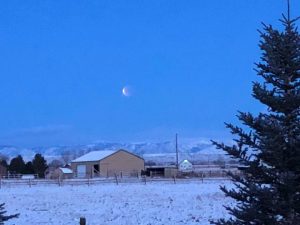
 head up to the Bluetooth Mountains as much as they can. There they all ride, and relax. Josh and Jala like to race the horses a little bit. Josh has taught Jala to ride very well. They love to fish and ride, as well as hunt and hike. Christmas on their country estate brings snow, and most likely a few moonlight rides in the crisp air. They really love Christmastime in their country home. For Josh, and his family, there is just nothing sweeter than livin’ the country life. Today is Josh’s birthday. Happy birthday Josh!! Have a great day!! We love you!!
head up to the Bluetooth Mountains as much as they can. There they all ride, and relax. Josh and Jala like to race the horses a little bit. Josh has taught Jala to ride very well. They love to fish and ride, as well as hunt and hike. Christmas on their country estate brings snow, and most likely a few moonlight rides in the crisp air. They really love Christmastime in their country home. For Josh, and his family, there is just nothing sweeter than livin’ the country life. Today is Josh’s birthday. Happy birthday Josh!! Have a great day!! We love you!!
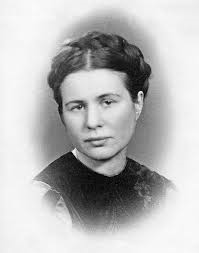 Some would consider the actions of Irena Sendler a crime, while others would consider them heroic. I suppose it was a crime, at the time it happened…a crime of opportunity, because her actions were illegal, but how could she had done anything different? Irena Sendler was born in Otwock, Poland, on February 15, 1910, to Stanislaw Henryk Krzyzanowski, a physician, and his wife, Janina Karolina Grzybowska Krzyzanowski. Irena grew up there in Otwock, a town about 15 miles southeast of Warsaw, where there was a Jewish community. Her father was a kind man who treated the very poor, including Jews, free of charge. Stanislaw died in February 1917 after he contracted typhus from his patients. After his death, the Jewish community offered financial help for the widow and her daughter, though Janina Krzyzanowski declined their assistance. I’m sure she knew they really didn’t have the money to help, but offered because of her husband.
Some would consider the actions of Irena Sendler a crime, while others would consider them heroic. I suppose it was a crime, at the time it happened…a crime of opportunity, because her actions were illegal, but how could she had done anything different? Irena Sendler was born in Otwock, Poland, on February 15, 1910, to Stanislaw Henryk Krzyzanowski, a physician, and his wife, Janina Karolina Grzybowska Krzyzanowski. Irena grew up there in Otwock, a town about 15 miles southeast of Warsaw, where there was a Jewish community. Her father was a kind man who treated the very poor, including Jews, free of charge. Stanislaw died in February 1917 after he contracted typhus from his patients. After his death, the Jewish community offered financial help for the widow and her daughter, though Janina Krzyzanowski declined their assistance. I’m sure she knew they really didn’t have the money to help, but offered because of her husband.
In 1931, Irena married Mieczyslaw Sendler, and the couple moved to Warsaw before the outbreak of World War II. The couple divorced in 1947. Irena then married Stefan Zgrzembski. They had three children, Janina, Andrzej (who died in infancy), and Adam (who died of heart failure in 1999). Then, they divorced in 1957. She remarried Mieczyslaw Sendler in 1961, but they divorced again in 1971. In college, Irena 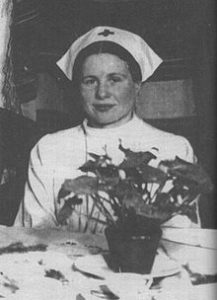 had studied to became a social worker, and she remembered the lessons of her father…to show kindness to others. It was a life lesson that would prove useful in Irena’s future.
had studied to became a social worker, and she remembered the lessons of her father…to show kindness to others. It was a life lesson that would prove useful in Irena’s future.
When the Nazis invaded Poland in 1939, Irena had access to the Warsaw Ghetto through her job. The ghetto was where hundreds of thousands of Jews were imprisoned. The situation there appalled her. Irena became a member of the Council to Aid Jews, and worked as a social worker, overseeing the city’s canteens, which provided assistance to people in need. After the Nazi invasion, Irena and her colleagues also used the canteens to provide medicine, clothing and other necessities to the city’s persecuted Jewish population. Her actions enabled her to help rescue 2,500 Jewish children from the ghetto. The group had several ways of smuggling the children out of the ghetto. Some were carried out in caskets or potato sacks, while others left in ambulances or snuck out through underground tunnels. Still others entered the Jewish side of a Catholic church that straddled the ghetto boundary and left on the other side with new identities. Irena then helped place the children at convents or with non-Jewish families. The operation was run with clockwork-like precision. As the situation grew worse for the ghetto’s inhabitants, Irena went beyond rescuing orphans and began asking parents to let her try to get their children to safety. Although she couldn’t guarantee the children’s survival, she could tell parents that their children would at least have a chance. The parents knew that it would be their  children’s only chance. Irena kept detailed records and lists of the children she helped buried in a jar. She planned to reunite the rescued children and their parents after the war. Unfortunately, most of the parents did not survive.
children’s only chance. Irena kept detailed records and lists of the children she helped buried in a jar. She planned to reunite the rescued children and their parents after the war. Unfortunately, most of the parents did not survive.
On October 20, 1943, the Nazis arrested Irena and sent her to Pawiak Prison. She was tortured in an attempt to get her to reveal the names of her associates. She refused and was sentenced to death. However, Council to Aid Jews members bribed the prison guards, and Irena was released in February 1944. Irena continued her work until the war ended, by which time she and her colleagues had rescued approximately 2,500 children. It has been estimated that Irena personally saved about 400 children. In 1965, Irena was honored for her courageous actions during the Holocaust. She was given Israel’s Yad Vashem to honor her as “Righteous Among the Nations.” Irena died in Warsaw, Poland on May 12, 2008, at the age of 98.

 My nephew, Steve Spethman is a guy who can do just about any job you need him too. He has big shoulders and muscled arms, and is always willing to do the heavy lifting…something many in the family have learned to appreciate from time to time. He has helped with several building projects, including my sister, Caryl Reed and her husband, Mike’s garage/apartment/wild game room. He did an amazing job on all the projects Mike asked his help with. He also helped build the back deck for our mom, Collene Spencer’s house, and a number of projects at his own home.
My nephew, Steve Spethman is a guy who can do just about any job you need him too. He has big shoulders and muscled arms, and is always willing to do the heavy lifting…something many in the family have learned to appreciate from time to time. He has helped with several building projects, including my sister, Caryl Reed and her husband, Mike’s garage/apartment/wild game room. He did an amazing job on all the projects Mike asked his help with. He also helped build the back deck for our mom, Collene Spencer’s house, and a number of projects at his own home.
Steve likes to work on cars, and he has recently been teaching his oldest son, Xander the ropes, as they worked on Xander’s girlfriend’s vehicle. Steve and his wife, Jenny, are working on getting used to having a son who is old enough to drive. That is a strange time in the life of a parent. Parents always feel like their kids will be little forever, even while they are watching the grow up before their eyes. They one day, when the aren’t looking, suddenly that child is driving on their own. It helps the family out, because their child can now help with driving the other children, but it’s hard to get used to.
Steve is a hard working man, but he is also a fun-loving guy. He like to take his family camping, and loves both the lake and the mountains. He is also a jokester. He likes to share funny memes from Facebook, and tell a 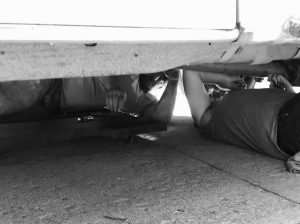
 good joke, something he is very good at doing. He loves to make people laugh, and is a “Tickle Torturer” from way back. I would know, because I have been his victim a time or two. I’m sure that many others have been a tickle victim of Steve’s because he just loves to pick on people…in a good way, of course. There are many sides to Steve, and our family likes them all, even the teasing ones. Today is Steve’s birthday. Happy birthday Steve!! Have a great day!! We love you!!
good joke, something he is very good at doing. He loves to make people laugh, and is a “Tickle Torturer” from way back. I would know, because I have been his victim a time or two. I’m sure that many others have been a tickle victim of Steve’s because he just loves to pick on people…in a good way, of course. There are many sides to Steve, and our family likes them all, even the teasing ones. Today is Steve’s birthday. Happy birthday Steve!! Have a great day!! We love you!!

 My grand-niece, Adelaide Sawdon is a cute little three year old girl who is…sassy!! I don’t mean to say that she is obnoxious, because that would be totally wrong. She just has a sassy personality. She is confident in her self, and in her place in her family. Maybe she is a little overconfident in her place in the family. You see, Adelaide thinks she is the boss of her family. She gets that attitude from her mom, Jessi Sawdon, who was sassy in her own right as a little girl. Jessi was the oldest child, and like her daughter, Adelaide, she was sure that she was not only the boss, but the mom!! She knew that she was the boss of her mom, even when she got in trouble for it. Adelaide is her mom’s mini-me on that. That’s our Addie!!
My grand-niece, Adelaide Sawdon is a cute little three year old girl who is…sassy!! I don’t mean to say that she is obnoxious, because that would be totally wrong. She just has a sassy personality. She is confident in her self, and in her place in her family. Maybe she is a little overconfident in her place in the family. You see, Adelaide thinks she is the boss of her family. She gets that attitude from her mom, Jessi Sawdon, who was sassy in her own right as a little girl. Jessi was the oldest child, and like her daughter, Adelaide, she was sure that she was not only the boss, but the mom!! She knew that she was the boss of her mom, even when she got in trouble for it. Adelaide is her mom’s mini-me on that. That’s our Addie!!
Adelaide is a very smart little girl. She knows her numbers, and she knows how many three is. She also knows that she was two until today, and that while she may have been one…once, one has nothing to do with her age now, not even in counting up to three. One is over, so figure it out!! Adelaide said that she wants to be five, so she can go to school, but I think her parents, Jessi and her husband, Jason, would rather wait just a little bit before she heads to school. For now, they want her to stay their baby girl for just a while longer.

 Adelaide is very excited for her birthday party today, because her parents are taking her to the Planetarium. She is learning all about that word, and what it means. She knows that she is going to see the planets at the “Pantarium.” Listening to the cute little ways she says words is so fun. Her Aunt Kellie, whom Adelaide called “Kayee” for the longest time has been one of the ones whose name came out funny, but now, Adelaide has learned to say Kellie. Her aunt was so excited, and so she clapped her hands and cheered. Addie liked that, so now she says Kellie a lot, followed by the face of anticipation…waiting for the cheers and clapping. Awww, the joys of life as a three year old. Today is Adelaide’s 3rd birthday. Happy birthday Adelaide!! Have a great day!! We love you!!
Adelaide is very excited for her birthday party today, because her parents are taking her to the Planetarium. She is learning all about that word, and what it means. She knows that she is going to see the planets at the “Pantarium.” Listening to the cute little ways she says words is so fun. Her Aunt Kellie, whom Adelaide called “Kayee” for the longest time has been one of the ones whose name came out funny, but now, Adelaide has learned to say Kellie. Her aunt was so excited, and so she clapped her hands and cheered. Addie liked that, so now she says Kellie a lot, followed by the face of anticipation…waiting for the cheers and clapping. Awww, the joys of life as a three year old. Today is Adelaide’s 3rd birthday. Happy birthday Adelaide!! Have a great day!! We love you!!
 My aunt, Dixie Richards is the middle sister of the younger three sisters of my mom, Collene Spencer. My grandparents, George and Hattie Byer had nine children. The first three were girls, the second three were two boys with my mom in the middle, and the youngest three were girls. It would have been almost like having three families, except that there wasn’t any significant distance between the sets of three. Even without big distances between the sets of three, there was a number of years between the oldest and the youngest of the kids. That could have made a sibling distance too.
My aunt, Dixie Richards is the middle sister of the younger three sisters of my mom, Collene Spencer. My grandparents, George and Hattie Byer had nine children. The first three were girls, the second three were two boys with my mom in the middle, and the youngest three were girls. It would have been almost like having three families, except that there wasn’t any significant distance between the sets of three. Even without big distances between the sets of three, there was a number of years between the oldest and the youngest of the kids. That could have made a sibling distance too.

I’m sure that with any big family, the older children are often married before the younger ones are born or at least before they are very old. That can make the memories seem a little distant for the younger children. Fortunately for my mom’s family, they were pretty close, so the sisters and brothers stayed close too. That gave all the cousins the opportunity to be close too. I know of cousins that barely know each other, but my cousins are close. We may not see each other every day or week, but we are all friends. We care about each other. That’s what families should be, I think.
 That sort of closeness is how Aunt Dixie’s family is too. They spend lots of time together. When Aunt Dixie and Uncle Jim had some health issues, the kids rallied around them to take care of them. When their girls, Jeannie Liegman and Raylynn Williams needed babysitters, Aunt Dixie and Uncle Jim watched the grandchildren. Their son Jim lives with them, which makes them feel good and safe. As people get older, it’s nice to have your kids near you, and it’s even nicer to have them want to help you. Of course, Aunt Dixie and Uncle Jim are there for their kids too, no matter what the need…physical or emotional. That is what family is all about, and Aunt Dixie has created a close family. Today is Aunt Dixie’s birthday. Happy birthday Aunt Dixie!! Have a great day!! We love you!!
That sort of closeness is how Aunt Dixie’s family is too. They spend lots of time together. When Aunt Dixie and Uncle Jim had some health issues, the kids rallied around them to take care of them. When their girls, Jeannie Liegman and Raylynn Williams needed babysitters, Aunt Dixie and Uncle Jim watched the grandchildren. Their son Jim lives with them, which makes them feel good and safe. As people get older, it’s nice to have your kids near you, and it’s even nicer to have them want to help you. Of course, Aunt Dixie and Uncle Jim are there for their kids too, no matter what the need…physical or emotional. That is what family is all about, and Aunt Dixie has created a close family. Today is Aunt Dixie’s birthday. Happy birthday Aunt Dixie!! Have a great day!! We love you!!

